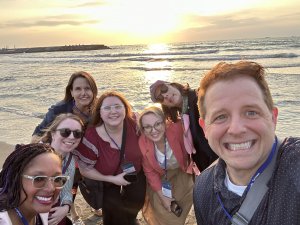Considering the whole process of my teaching career a chapter book, to be able to come to America and learn again seems to be the best chapter of all. It is like a dream come true. I would like to express my sincere gratitude to The U.S. Department of State and Fulbright Taiwan Commission for granting me the prestigious opportunity of becoming a part of the Fulbright Distinguished Awards in Teaching Program for International Teachers (FDAI). It has been a fruitful journey. Not only did the program broaden my horizon as a teacher, but it also provided potential solutions to the challenges I am facing in the classroom.
Although my adventure in the U.S. was disrupted by the outbreak of COVID-19 pandemic, the amount and value of information collected was still overwhelming. Eventually, the report of my inquiry project will serve as a resource bank of research-based teaching practices for the teachers who try to teach ability-grouped classrooms in Taiwan’s elementary schools.
Focus Identified
Taiwanese English teachers recognize the biggest challenge in the classroom as the gaps that exist between students’ proficiency levels. These gaps make it difficult to teach effectively. Multiple attempts including in-class peer tutoring, pull-out morning remedial instruction by voluntary parents and the after-school alternative program have been made to solve the problem. The most recent pilot of an ability grouping program (two classes, three groups) that provides a module of “pull-out” remediation for students who need support was reported to have had encouraging outcomes (Taipei City Government, 2016). However, little information related to pedagogy and materials has been released.
Ability Grouping in Taiwan
Ability grouping is a common practice used in education. The primary purpose for grouping students by ability is to increase their academic growth and achievement by providing instruction at the students’ current learning level. In Taiwan, there are two major grouping models after dividing students into three ability levels (A-B-C). In one model, classes are remixed into separate classes or group A, group B and group C students (AA-BB-CC model). In the other model, group A and group B students remain in their original classes, while group C students are pulled to form a new class (AB-AB-CC model).
Many teachers who piloted the ability-grouping program in different areas across the island suggested the AB-AB-CC model which reduces the labeling effect on the group B students. In addition, a smaller size of group C is also recommended to provide group C students with more intensive support and attention.
The Encounter with Multi-Tiered System of Supports (MTSS)
The inspiration of adopting the Multi-Tiered System of Supports (MTSS) framework came from a goal-setting meeting during an in-service workshop I attended with my partner teacher from a rural elementary school in Indiana County, Pennsylvania. MTSS is an umbrella term for Response to Intervention (RTI) and Positive Behavioral Intervention and Supports (PBIS) to address academic and behavioral challenges. According to the Pennsylvania Training and Technical Assistance Network (PaTTAN), MTSS is a standards-aligned, comprehensive school improvement framework for enhancing academic, behavioral, and social-emotional outcomes for all students. A key component of MTSS is the tiered structure that offers a range of interventions based on the needs of individual students. Other core components of MTSS (Colorado Department of Education, 2015) are: (1) Evidence-based curriculum and instruction provided at the universal level; (2) Universal screening of all students; (3) Evidence-based, instructional interventions at the targeted and intensive levels shall be provided to each student who needs them; (4) Progress monitoring for learners below expectations; and (5) Data-based decision making throughout the system.
The above components and goals of MTSS coincide with those of the ability-grouping program that my school is launching in the new school year of 2020.
The purpose of this project, therefore, was to investigate the “what” and the “how” of the MTSS framework that can be implemented into the ability-grouped classrooms in Taiwan. More specifically, what pedagogical strategies as well as teaching and learning materials can be feasibly adopted to bridge the gaps between students’ proficiency levels?
Sources of Information
Information was collected from two sources for the report. The first source was the classroom observations and informal discussions with the teachers carrying out the program in two elementary schools in Pennsylvania, U.S.A. The second was the data collected from the FDAI seminars and the tech workshops at Indiana University of Pennsylvania designed for the FDAI program.
Classroom Observations
As an EFL (English as a Foreign Language) teacher, my observation sites were mainly ELA (English Language Arts) classrooms hosted by fourth grade homeroom teachers for Tier 1 general instruction and ESL classrooms hosted by both reading support specialists and ESL teachers for Tier 2 and Tier 3 instruction. The focus of the observations was teachers’ instructional procedures, content, learning activities and assessment tools. All queries were verified in real-time with the teachers during recess. The purpose of this report is to create an informational resource bank for the elementary English teachers in Taiwan. Therefore, instead of just giving the names of the activities, I strived to make the teaching procedures and activities as descriptive as possible for the audience’s better understanding.
With the teachers’ permission, I took pictures of teacher-student, student-student, and student-environment interactions. I also made visual recordings to make a comprehensive record of the teacher’s talk, presentation of materials, and strategies to enhance students’ learning. In addition, I drew the classroom layouts to reflect the setting for differentiated activities in which each group was engaging. Eventually, a total of eleven observations were made.
FDAI Seminars and Tech Workshops at Indiana University of Pennsylvania
On one hand, the FDAI seminars empowered international teachers by training participants in leadership, making teamwork count, enhancing critical thinking, promoting a growth mindset, strengthening techniques for doing action research, along with broadening our views on different education systems and their related issues. These seminars served as professional development for me as a teacher and as a teacher-trainer for efficient application of pedagogical approaches. On the other hand, the tech workshops encompassed an introduction to educational applications and platforms, an alternative online education, and a tour of the education technology exhibition. They equipped me with new concepts and potential applications of educational technology that can enhance interactivity and make more efficient instruction and learning possible in classrooms.
Information Analysis
The results included the description of the curriculum-aligned materials, designed activities, used technology, teaching strategies and general teaching practices in ELA and ESL elementary school classrooms at a rural area of Pennsylvania.
Station Learning or Center Learning
One particular strategy used widely across grade levels in Pennsylvania is station learning, which is an approach that students rotate from different learning centers, and differentiation in learning is allowed. The learning centers most often focus on five domains, which are guided reading, word work, work on writing, read to self and iReady. In the classrooms I observed, seating arrangements and activities designed for learning centers varied across classrooms. A picture of the layout of a fifth grade classroom is attached as follows:
To conclude, station learning uses the practices of record keeping, rotations between stations of academic contents, student choices, and monitoring of students by teachers at most stations. The four research-based strategies for implementing stations or centers that encourage effective instruction, learning, and efficient physical layout were to (1) group students properly, (2) differentiate the work in the centers and stations, (3) manage the flow of movement, and finally (4) constantly re-evaluate the groups (Henderson, 2015).
MTSS Materials
MTSS employs evidence-based curriculum and instruction in the classrooms. At EES, Pennsylvania, a building for G4-5, the curriculum used is Benchmark Literacy which is a research-based literacy program covering listening, speaking, reading, and writing skills. In addition to the Benchmark Literacy program, teachers added more materials to the daily instruction. Two activities repeated every day were the 5x and Scrabble Practice. 5x is for students to copy the power words of the day in their notebooks in different formats. In Scrabble Practice, students put the provided power words on the scrabble game sheet and try to find a way to gain as many points as they can. On top of 5x and Scrabble Practice, Five-a-Day language review was included to serve as a supplementary material for students to work on language skills and grammar points. The teacher tried to use the short, daily, reproducible tasks to build new skills and review previous skills.
At EPES, a building for PreK-3, the main curriculum is Fundations Wilson Language Basics and it is accompanied with Heggerty by Literacy Resources, LLC, to train students with phonemic awareness skills. Fundations Wilson Language Basics was also used as the curriculum for ESL instruction across grade levels from first grade through fifth grade.
Teaching Practices
For teachers’ implementing the teaching strategies and feasible activities in their classrooms, it is imperative to elaborate the procedure and contents descriptively. For the general instruction in the Tier 1 classroom, I reported the theoretical background and the instructional strategies of close reading, fluency practice along with using exit tickets as a formative assessment which is an example of integrated language learning. For the Tier 2 and 3 classroom, I included a description of a phonemic awareness training session, hand-on activities for sound manipulation with Letter Board and a set of visual phonics. Anecdotal records of the process were made to show student responses to the teacher’s prompts. Moreover, a verbatim transcription of the guidance of the reading specialist as well as students’ correspondence were included in the report. Coupled with the above, one of the 21st century life skills, keyboarding skill, was introduced specifically with the procedure of instruction done by the Business, Computer and Information Technology (BCIT) teacher.
Educational Technology
Although educational technology is not a total stranger to English teachers in Taiwan, what I saw in the classrooms at Indiana Area School District and what I experienced in the tech workshops repeatedly surprised me.
Platforms and Devices in the Classrooms
The observed schools created a technology-rich environment. Each classroom is equipped with an interactive whiteboard and a visual presenter. In addition, a Chromebook was provided to each student to use at school for instructional purposes. By providing students with internet access, digital course materials and digital textbooks, the school’s curriculum was increasingly enhanced by technology. Teachers used Google Classroom to create classes, distribute assignments, grade and send feedback.
Resources of Educational Technology
For those applications and platforms that have been used in my country, I learned how to apply them in new ways and with a new perspective. Eventually, I was able to construct multiple informational tables which were divided into categories for different end users. For each website or application, I provided a brief introduction, an icon for better identification, a QR code and a link to make a prompt access. The four categories are stated as follows: (1) Ready-to-use resources for elementary students – ABCYa, Starfall, Reading A-Z, Newsela, epic!, Sight words: Kids Learn!, noredink, Spelling City; (2) Ready-to-use resources for teachers – Zearn, DIBELS, Jack Hartmann YouTube channel; (3) Applications that facilitate interaction and creativity – padlet, nearpod, Pear Deck, goosechase, Flipgrid, plickers, BOOK CREATOR; and (4) Tools that increase productivity – Gynzy, Screencastify, ZipGrade.
Discussion of Applying MTSS to Taiwan’s Classrooms
The results revealed a wide range of feasible resources and effective teaching practices and strategies. However, some limitations can be found in Taiwan’s elementary school setting such as (1) short time frame for English instruction, (2) a lack of educational budget in implementing co-teaching in the classrooms, (3) limited availability of instructional technology resources, and (4) insufficient knowledge of teachers and students to use the instructional technology.
Given these limitations, I could still visualize potential ways of implementing MTSS framework in the ability-grouped classrooms in Taiwan from the insights I gained during this program That is: (1) make good use of devices in the classroom to support explicit instruction; (2) employ workable learning routines and daily activities like 5-a-Day, Rainbow Words fluency training, and phonemic awareness training; (3) clearly specify expectations and keep good relationship to create a sense of community; (4) provide students and their family with links to properly selected resources with necessary instruction and establish schedules with achievable goals for reading and practicing outside the classroom; and (5) offer ample opportunities for technology-related professional development by the government for effective implementation, including training on how to efficiently address common technical issues to minimize disruptions to classroom learning.
Conclusion
Quoted by Robert Noyce, “Knowledge is power. Knowledge shared is power multiplied.” It may best describe the FDAI program. This program enabled me to develop professionally by learning different possibilities on teaching strategies, planned activities, and instructional technology in the classrooms. I have the confidence in setting up a feasible model for an ability-grouped classroom for fourth-grade students in the coming school year and sharing with my fellow teachers in Taiwan. The FDAI program also provided me with the chance of meeting brilliant educators from around the world. So, what’s next? I guess it will be leading our students to connect with the world, and I am convinced that together we can make it happen.
Managing editor: Cheng-Hsiung Lu 呂正雄
References
Henderson, D. (2015). That’s Special: A Survival Guide to Teaching. Outskirts Press: Denver, U.S.A.
Taipei City Government, Department of Education (2016, May 27). 臺北市國中小創新教學英語實驗計畫-兩班三組教學模式成效良好 105學年度賡續辦理 [Press release].
Colorado Department of Education. (2015, May). What is MTSS?
For more information, please check on my full report.





